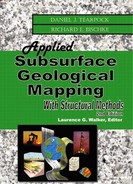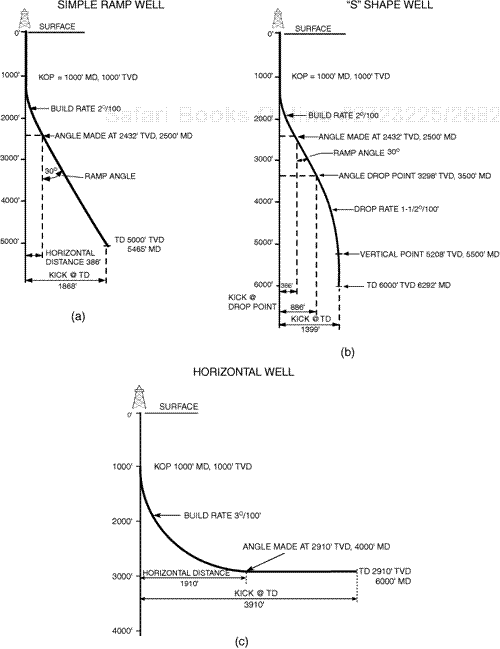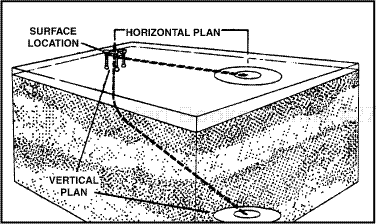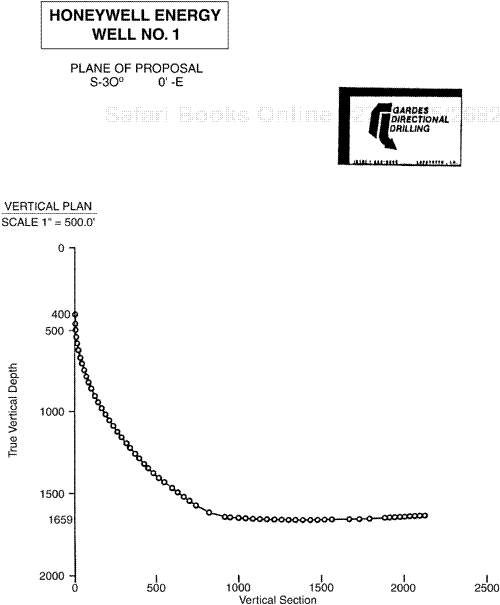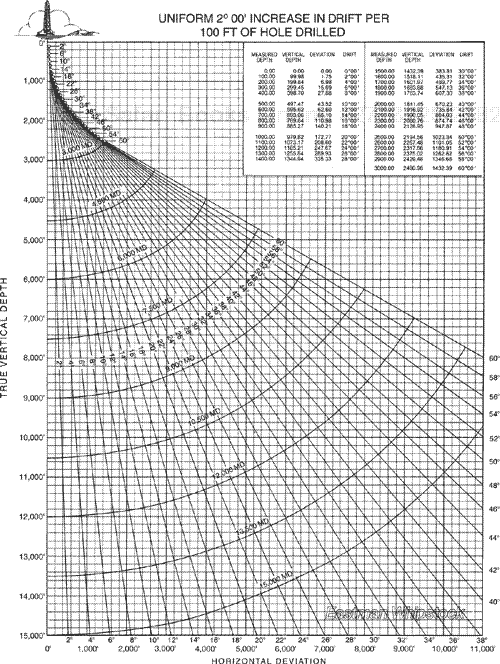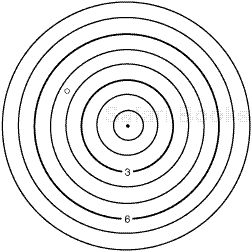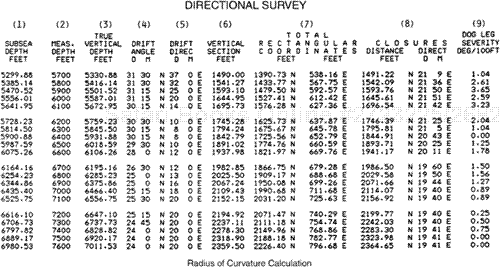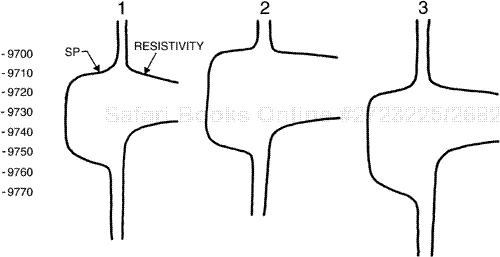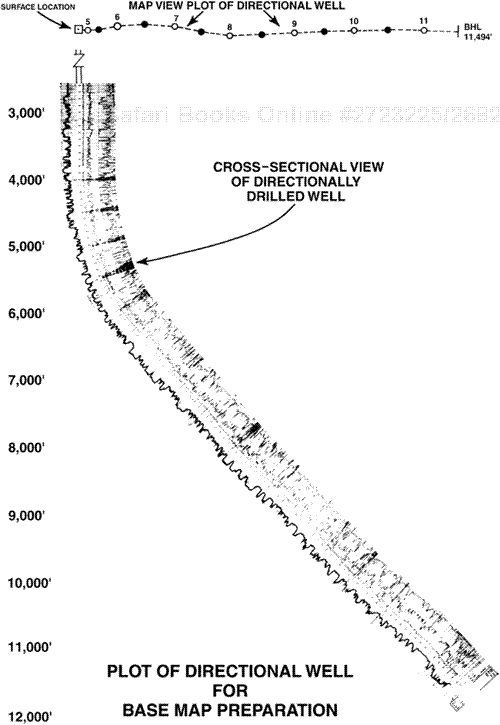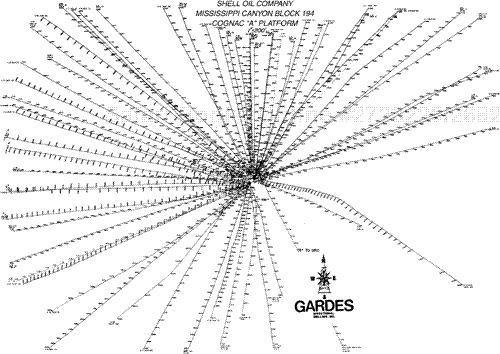A directionally drilled or deviated well is defined as a well drilled at an angle less than 90 deg to the horizontal (Fig. 3-1). Wells are normally deviated intentionally in response to a predetermined plan; however, straight holes often deviate from the vertical due to bit rotation and natural deviation tendencies related to rock types and structure.
The technique of controlled directional drilling began in the late 1920s on the U.S. Pacific coast (LeRoy and LeRoy 1977). Through the use of controlled directional drilling, a wellbore is deviated along a preplanned course to intersect a subsurface target horizon(s) at a specific location (Fig. 3-2). Our primary interest in directionally drilled wells in this textbook centers around their application to subsurface mapping.
There are a number of reasons to drill a directional well. Some of the more common applications are shown in Fig. 3-3. The most common application is the drilling of offshore wells from a single platform location (Fig. 3-3a). The use of a single platform from which multiple wells are drilled improves economics and simplifies production facilities.

(From LeRoy and LeRoy 1977. Published by permission of the Colorado School of Mines.)
Figure 3-3. Applications of directional drilling. (a) Multiple wells offshore or from artificial islands. (b) Shoreline drilling. (c) Fault control. (d) Inaccessible surface location. (e) Stratigraphic trap. (f) Relief well control. (g) Straightening hole and side tracking. (h, i, j) Saltdome drilling.
Onshore, wells are commonly deviated due to inaccessibility to the surface location directly over the subsurface target. Buildings, towns, cities, rivers, and mountains are the kinds of surface obstructions that require the drilling of a deviated well. Horizontal wells are a special type of directional well. They have many applications, most of which are designed to increase productivity rate and improve project economics. These wells are discussed in more detail in the next section.
One very important safety application of a deviated well is the drilling of a relief well to kill a well that has blown out (Fig. 3-3f). There are other applications of deviated wells, but they are beyond the scope of this textbook and are not discussed.
There are many complex factors that go into the design of a directionally drilled well; however, most deviated wells fall into one of three types. The most common type is a simple ramp well (Fig. 3-1a), sometimes called an “L” shape hole. These wells are drilled vertically to a predetermined depth and then deviated to a certain angle, which is usually held constant to total depth (TD) of the well. Many wells are drilled with an “S” shape design. For an “S” shape hole, the well begins as a vertical hole and then builds to a predetermined angle, maintains this angle to a designated depth, and then the angle is lowered again, often going back to vertical (Fig. 3-1b). Finally, horizontal wells are configured by continuously building the deviation angle until the desired near-horizontal orientation is reached (Fig. 3-1c).
The terms used to describe various aspects of a directionally drilled well are defined here and illustrated in Fig. 3-1.
KOP | Kick-off point. Depth of initial deviation from vertical measured as measured depth (MD), true vertical depth (TVD), or subsea true vertical depth (SSTVD). |
Build Rate | Build angle. Rate at which the angle changes during deviation. It is usually expressed in degrees per 100 ft drilled. Example: 2 deg per 100 ft. |
Ramp Angle | Hole angle, drift angle, angle of deviation. Angle from the vertical that a well maintains from the end of the build through the ramp segment of the well. |
BHL | Bottom-hole location. Horizontal and vertical coordinates to the total depth point usually measured from the surface location. |
Drop Rate | Rate at which the ramp angle changes in degrees per 100 ft. Measured in “S” shape holes. |
Vertical Point | The depth where the well is back to vertical, measured as MD, TVD, or SSTVD. |
Horizontal wells are typically considered to be wells with the borehole drilled within about 3 deg of bed dip or wells drilled nearly horizontally. These include extended reach wells with long horizontal displacements, as well as long and medium radius horizontal wells. Short radius horizontal wells are often called drain hole wells.
Extended-reach wells can be similar to the “S” shape well, but with very high ramp angles in the 80 deg range. Although they are nearly horizontal, they might not be considered true horizontal wells. These wells are generally drilled when the surface location is necessarily a great distance from the target. Long-radius horizontal wells have build rates in the 3 deg/100-ft range and generally the horizontal part of the borehole is several thousand feet in length. Medium radius horizontal wells have build rates in the 30 deg/100-ft range and are usually drilled for shallow objectives. Short radius horizontal wells are borehole segments drilled from a vertical borehole that penetrated the objective interval, with the deviation from vertical to horizontal made within a vertical interval of about 20 ft. These wells usually have horizontal segments of only a few hundred feet, but several horizontal segments may be drilled from the same vertical wellbore. These drain hole wells are used in low permeability reservoirs and enhanced recovery projects.
The purpose of drilling most horizontal wells is to improve the economics of a project by increasing production rates and shortening well life. For example, horizontal wells can improve production rates from (1) reservoirs containing heavy oil, such as the Orinoco heavy oil belt (Venezuela); (2) reservoirs with mostly fracture porosity, such as the Austin Chalk (onshore Gulf of Mexico); and (3) reservoirs of low permeability. Horizontal wells can also be used to penetrate and produce from multiple reservoirs that are laterally discontinuous. For example, separate fluvial channel sands that are in the same stratigraphic interval but are laterally discontinuous can be penetrated by a single horizontal well to drain multiple sand bodies. Also, for multilobed reservoirs with attic reserves above the highest wells on the structure, a horizontal well can be designed to encounter all the lobes, whereas a vertical well might miss some of the lobes that truncate up-dip. Another application of horizontal wells is to drill for thin oil zones over water. These zones are subject to coning of water into vertical wells. A horizontal well can significantly reduce the problem of water coning. There are other applications of horizontal wells, but most well plans are based on increasing production rates and shortening well life to improve project economics.
A variety of data go into the design of a directionally drilled well, including the depth and distance from the surface location to each subsurface target, diameter of the target, KOP, build rate, platform location, lease lines, hole size, and total depth of the well. Once preliminary studies indicate the need for a deviated well, most companies rely on a directional drilling service company to prepare the final directional plan.
A directional well design consists of both vertical and horizontal plans. Figure 3-4 shows the horizontal and vertical plans for the Diamond Shamrock Well No. 1. Reviewing Fig. 3-4a, we see that the KOP for this well is about 950 ft measured MD, and the build rate averages about 2 deg per 100 ft to a maximum deviation angle of 45 deg 30 min at a measured depth of 4800 ft. Figure 3-4b shows the horizontal plan for the well. The plane of the proposed direction is south 46 deg 25 min west from the surface location with the BHL 10,873 ft from the surface location. The well is drilled to a MD of 19,484 ft, which is equal to a TVD of 15,695 ft.

(Published by permission of Gardes Directional Drilling.)
Figure 3-4. (a) Vertical section plan for a directional well. (b) Horizontal plan for the same directional well shown in Fig. 3-4a.
A grid reference for north is shown in Fig. 3-4b. Several coordinate systems exist for industry’s use and, unfortunately, it is common for the data sources (e.g., directional well surveys and seismic surveys) and maps used in a project to be in different coordinate systems. It is critical that all of them be converted to the same system to reduce errors in location.
Figure 3-5 illustrates the vertical plan for a well that has a maximum deviation angle of 94 deg and a maximum build angle of 14 deg per 100 ft. The wellbore is vertical near the surface, and at a depth of 1659 ft (TVD), it is horizontal.
Commonly, deviated wells are drilled with a build rate of 2 deg per 100 ft of hole drilled. Figure 3-6 shows the scaled chart for a 2 deg per 100 ft build rate. Such charts are used to make a quick estimate of well design after structure maps have been made on target horizons. For example, from the chart, a target horizon located at a TVD of 10,000 ft and a horizontal distance of 4000 ft from the platform location requires the drilling of a well with a deviation angle of approximately 23 deg to a MD of 10,800 ft. Such charts are available from directional service companies for build rates ranging from 1 deg to 5 deg per 100 ft.
Three features of a directional wellbore are measured at given points within the well: (1) measured depth, which is the distance from the surface to a given point, measured along the wellbore; (2) angle of inclination from the vertical (drift angle or deviation angle); and (3) drift direction, or the directional path of the wellbore. These parameters are the basis for calculations of the position of each point in the subsurface, and all this information is included in a directional survey. Drift angle and drift direction are measured by a survey tool conveyed in drill pipe or by wireline, and measured depth is determined by length of drill pipe or wireline. The various tools that are used fall into two categories: magnetic and nonmagnetic.
Magnetic is a generic term for describing several survey tools that use a magnetic compass for direction and therefore must be run inside a special nonmagnetic drill collar to negate the effects of the drill pipe. An example of such a survey is the “single shot” magnetic survey. This device records, on a heat-resistant film disc, the magnetic direction and inclination angle of the wellbore at specific depth intervals. A “multishot” survey uses a filmstrip to record several readings of hole angle and direction at different depth intervals. Newer wireline tools provide real-time survey data at the surface. Measurement accuracy of magnetic survey tools has been improved within the last 20 years. Modern magnetic tools are used for measurement-while-drilling (MWD) surveying. These surveys provide real-time data for more efficient directional drilling.
Nonmagnetic survey tools are of two types: those with no direction-finding device and those with a gyroscopic mechanism for determining direction. A drift indicator tool (e.g., a Totco tool) measures only drift angle and is usually run in vertical wells or shallow vertical sections of deviated wells where directional information is not required. This tool generally consists of a housing or barrel, a motion indicator, a timer, a punch, and a printed paper disc. The unit is either run on a wireline or dropped on a drill bit. When the motion sensor determines that the tool is no longer moving, the timer is activated, and after a predetermined interval of time the punch is released. The punch, which is allowed to swing freely and act as a plumb bob, drops vertically and punches a hole in the paper disc, which is marked in degrees. Figure 3-7 shows a Totco disc scaled to a maximum of 8 deg. The hole punched in the disc indicates an inclination angle of 4.5 deg, but the drift direction is unknown.
Gyroscopic survey tools are widely used and are capable of providing more accurate data than magnetic survey tools. Because the magnetic compass is replaced by a gyrocompass, the system can be run in both cased and uncased holes and run where cased holes are nearby, as in a platform well cluster. The gyro system can be set up as a single or multishot instrument. Conventional tools, referred to as “free” gyros, are less accurate than the newer “rate” gyros, which are of different construction. A gyro survey is sometimes run after an MWD magnetic survey to provide additional information for well path determination. Newer types of gyroscopic tools are currently being tested, including an MWD gyro tool.
More than 20 methods have been developed to calculate the directional survey, which provides the three-dimensional location of a directional wellbore anywhere along its entire length. The more common methods include (1) tangential, which is the least accurate and no longer used; (2) trapezoidal, also called balanced tangential; (3) average angle; (4) radius of curvature; and (5) minimum curvature. Many companies have their own methods, and new algorithms are occasionally published. The accuracy of any method varies with the configuration of the wellbore. The radius of curvature and minimum curvature methods are the most widely used today, and the latter is considered slightly more accurate for most wells. The method of calculation is typically noted on the survey. If you work in an area with deviated wells and surveys of different vintages, you can reduce the wellbore position uncertainty due to calculation method by using the same algorithm, such as minimum curvature to recalculate all surveys. Computer software for this is readily available.
Three measurements go into the directional survey: (1) measured depth, (2) deviation angle, and (3) direction of deviation. These measurements, taken at specific depth intervals, are used to calculate the directional survey of a well. Figure 3-8 shows a portion of the directional survey from a deviated well. The tabular printout for this directional survey has nine separate columns of data for each survey point in the well.
Column | Data |
|---|---|
1 | Subsea depth of wellbore in feet |
2 | Measured depth of wellbore in feet |
3 | True vertical depth of wellbore in feet |
4 | Angle of wellbore deviation (inclination angle) |
5 | Direction of wellbore (true bearing) |
6 | Distance in feet from the surface location along the proposed directional path |
7 | True bearing and distance of each survey point from the surface location in rectangular coordinates |
8 | True bearing and distance from surface location directly to each survey point |
9 | Maximum change in hole angle in degrees per 100 ft |
If the cased or surface section of the hole was surveyed with a nonmagnetic survey tool such as a drift indicator, the angle of the cased portion of the hole will be displayed on the survey along with an estimate of the maximum possible deviation of this portion of the hole, as shown in Fig. 3-9. The 146.75-ft maximum deviation, prominently shown on the survey, indicates that if the wellbore drift in the cased portion of the hole were all in the same direction, the well at a depth of 3513 ft could be as much as 146.75 ft from the surface location. Notice at the end of the survey that it indicates that the bottom of the hole lies within a circle of radius 146.75 ft with its center located 203.94 ft south 63 deg 27 min west of the surface location. Such information may be important in fault, structure, and isochore mapping.
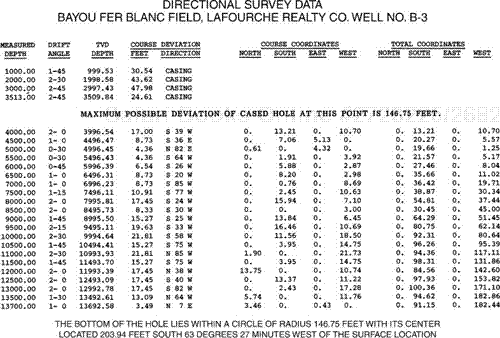
Figure 3-9. A directional survey from a well in which the surface casing was surveyed with a Totco tool providing deviation angle but not direction. Notice, at 3513 ft, that the maximum possible deviation of the cased hole is 146.75 ft. This assumes that the wellbore deviation in this portion of the hole was in one direction.
Directional surveys are used to plot wellbores on base maps. The applications of these plots are discussed later in this chapter.
The error introduced by the method of calculation becomes almost academic when the other directional survey uncertainties are considered. Uncertainty in measurement can be directly related to the type of survey tool and its operating condition and procedures. The diagrams in Figs. 3-10 and 3-11 are derived from a predictive mathematical model that was based on extensive research on North Sea wells by Wolff and de Wardt (1981), who showed that position uncertainties of boreholes are controlled by systematic errors. Vertical uncertainty (Fig. 3-10) refers to inconsistencies in determination of depths. Lateral uncertainty (Fig. 3-11) applies to inconsistencies in determination of lateral position. Magnetic surveys are compared to gyroscopic surveys. The magnetic and free gyroscope surveys display a significant range of potential inaccuracy, which can be due to the quality of survey equipment, operating procedures, and wellbore position. Note that more highly deviated wellbores are subject to more uncertainty in position. The actual predicted amounts of inaccuracy are not directly applicable to areas other than the North Sea, circa 1970, for a variety of reasons. For example, a higher latitudinal position produces more uncertainty in magnetic surveys. Also, the mathematical model does not apply to horizontal wells, including extended-reach wells. Many companies have detailed proprietary information about degree of error in particular types of survey tools, as used under certain operating conditions in given areas.
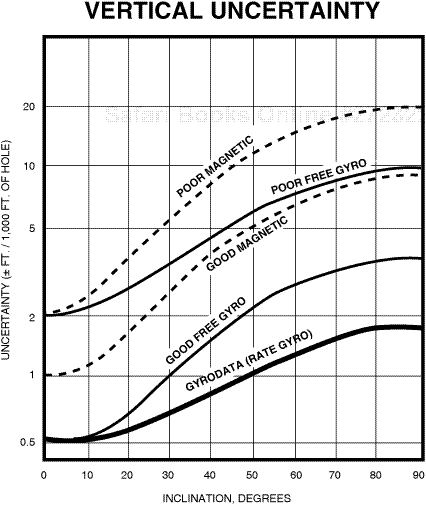
(Modified from Wolff and de Wardt 1981. Published by permission of the Journal of Petroleum Technology and Gyrodata, Inc.)
Figure 3-10. Expected vertical uncertainty in a deviated well considering various types of surveys.

(Modified from Wolff and de Wardt 1981. Published by permission of the Journal of Petroleum Technology and Gyrodata, Inc.)
Figure 3-11. Expected lateral uncertainty in a deviated well considering various types of survey tools.
Tenneco Oil Company conducted a detailed study of directional survey uncertainties in 1980. An important conclusion from the study indicates that there is a 90 percent certainty that any directional well will have an error of 35 ft or less TVD and 140 ft or less in departure. This conclusion is drawn irrespective of MD, hole angle, or survey type. This means that wells with hydrocarbon contacts that vary up to 35 ft TVD may well be in the same reservoir, with the variations due merely to survey error rather than such geological factors as permeability barriers or faults.
Today’s directional surveys are potentially more accurate than those described above, provided that the tools and operating procedures are of high quality. However, that does nothing to mitigate the errors inherent in surveys of older wells. Always remember that data based on directional wells, including new wells, should not be taken at face value. Apparent discrepancies in data used in mapping may be due to errors in depth and lateral position of points in wells. For example, the depth of a mapped surface or a water contact in a deviated well may not match satisfactorily with depths at nearby points. The reason could be an error in the directional survey or perhaps in the spotting of the wellbore. The same caution applies even to data discrepancy in a vertical well, which may have a significant but unrecognized deviation from the vertical.
Survey errors can be corrected in some cases in fields that have hydrocarbon/water contacts. Wells are often “corrected” to fit the contact. This is usually done by selecting a contact that fits most of the wells and then adjusting the depth of the well(s) that does not fit. An example of how to adjust a well is shown in Fig. 3-12. The water contact in Wells No. 1 and 2 is at a depth of –9738 ft, whereas the contact in Well No. 3 is at a depth of –9748 ft. Since data from two wells are in agreement with a water contact at –9738 ft, Well No. 3 is adjusted upward 10 ft to correct the water level from –9748 ft to –9738 ft. Not only is the water level corrected, but the structural depths of the sand (top and base) are also corrected upward 10 ft. Therefore, the top of the sand at a depth of –9720 ft becomes –9710 ft. An understanding of directional survey errors can at times eliminate the need for a “production fault” or “permeability barrier” to explain discrepancies in water levels.
Directional survey data are used to determine the depth and lateral position of the borehole along its entire length. These data are normally plotted on a base map in one of two ways: (1) as straight lines from the surface to BHL, or (2) as detailed directional plots.
The simplified straight-line method of plotting a directional well is shown in Fig. 3-13a. The only data required and plotted on the base map are the surface location and BHL, which may be the only data available. The MD to TD may be recorded next to the BHL. A straight dashed line is usually drawn between the surface location and BHL. This directional well plot provides absolutely no information about the position or depth of the wellbore in the subsurface between the surface and bottomhole locations. Such a plot is not helpful in the interpretation, construction, and evaluation of fault, structure, or isochore maps.
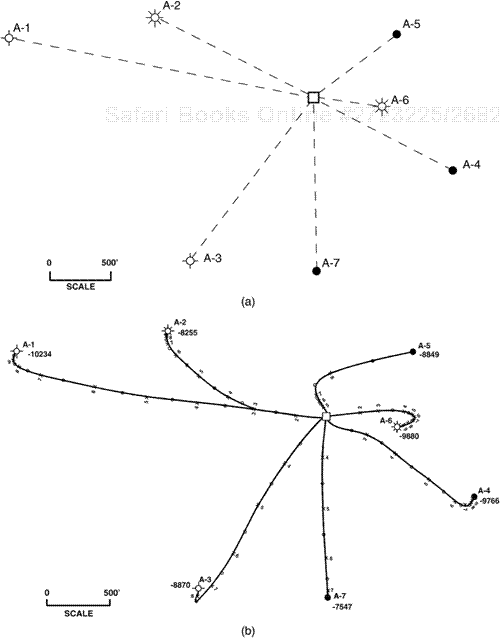
Figure 3-13. (a) Straight-line method of plotting directional wells in map view. (b) Detailed plot of directional survey data indicating the location and subsea depth of the wellbores along their entire length. Compare this plot to that in Fig. 3-13a.
When directional survey data are actually plotted to provide detail as to the lateral position and subsea depth of the wellbore, as shown in Fig. 3-13b, the plot has real value. Such a plot provides a visual guide (in map view) to the location and subsea depth of the wellbore anywhere along its path. It saves time in preparing subsurface maps and is extremely helpful in the interpretation, construction, and evaluation of fault, structure, and isochore maps. Later chapters examine several important benefits to fault surface and structure mapping derived from plotting on a base map the actual location and subsea depth, at fixed increments (usually 500 ft or 1000 ft), of all directional wells.
Figure 3-14 illustrates the cross-sectional view of a directionally drilled well and the detailed map-view plot of the directional data in 500-ft increments of subsea TVD along the actual well path. If subsea data are to be used in mapping, the directional well data are corrected to subsea before being plotted on the base map.
Figure 3-15 shows the map-view well plot for the Cognac “A” Platform in the Mississippi Canyon Block 194 in the U.S. Gulf of Mexico. The platform is the largest multiple-well platform in the world. The platform is located in 1000 ft of water and has a total height of 1260 ft. Wells were deviated with high angles, up to 75 deg. Horizontal displacements up to 11,500 ft result in a well pattern that covers an area with a diameter of more than 4 mi. Total cost for the project was over $1 billion.
